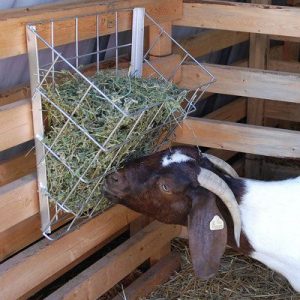In this blog article, we will discuss the importance of a well-balanced feeding plan for goats on zero grazing and provide guidelines for creating a nutrient-rich diet to ensure their optimal health and productivity.
1. Understand the Nutritional Requirements:
Before designing a feeding plan, it is crucial to understand the nutritional requirements of goats. The main components of a goat’s diet include energy, protein, minerals, vitamins, and roughage. The specific requirements vary depending on factors such as age, stage of production (e.g., lactation or growth), and breed.

2. Quality Roughage:
Roughage, such as hay or forage, should form the basis of a goat’s diet. It provides fiber, which aids in digestion and prevents digestive disorders. Ensure that the roughage is of good quality, free from mold, dust, and weeds. Common options for goat roughage include alfalfa, clover, grass hay, and legume hay.

3. Concentrate Feed:
To meet the energy and protein needs of goats, a concentrate feed should be included in their diet. This can be a commercial goat feed or a custom-made mix. The concentrate feed should contain a balance of grains, such as corn, barley, or oats, along with protein sources like soybean meal or sunflower meal. Consult with a livestock nutritionist to determine the appropriate ratio of roughage to concentrate feed based on your goats’ specific requirements.

Note that our company can help you to start by giving you all necessary information you need to get started. in our online shop we have standard business plans for different capacities at very cheap price as well as Standard design plans that are made by the best agricultural architects around the globe. please visit our shop now using the links below to witness by yourself
Design plans (FARM HOUSE DESIGNS – Kimd Construction & Farm Consultants)
Business plans (BUSINESS PLANS & PROPOSALS – Kimd Construction & Farm Consultants)
Well come back from there! Let us continue with the article!
4. Mineral and Vitamin Supplements:
Goats on zero grazing may require additional mineral and vitamin supplements to meet their nutritional needs. Common supplements include salt, calcium, phosphorus, and vitamins A, D, and E. These supplements can be provided in the form of mineral blocks or loose minerals. Consult with a veterinarian or livestock nutritionist to determine the specific requirements and appropriate supplementation for your goats.

5. Feeding Schedule:
Establishing a regular feeding schedule is important for goats on zero grazing. Aim to provide small, frequent meals throughout the day to mimic natural grazing behavior. Divide the daily ration into multiple feedings, with intervals of 4-6 hours between each meal. This helps maintain a healthy rumen function and prevents overeating.

6. Water Availability:
Access to clean and fresh water is essential for goats’ overall health and proper digestion. Make sure water is readily available at all times, and regularly clean and refill water containers to prevent contamination.

7. Monitoring and Adjustments:
Regular monitoring of the goats’ body condition, weight, and overall health is crucial. Adjust the feeding plan as needed based on changes in their nutritional requirements, growth, and production stages. Consult with a veterinarian or livestock nutritionist for guidance on adjustments to the feeding plan.
Conclusion:
A well-designed feeding plan is key to ensuring the health and productivity of goats on zero grazing. By providing a balanced combination of roughage, concentrate feed, mineral supplements, and access to clean water, you can meet their nutritional needs and promote optimal growth and performance. Regular monitoring and adjustments to the feeding plan will help maintain the goats’ health and well-being. Remember, consulting with experts in livestock nutrition and veterinary care is essential for personalized guidance and advice for your specific goat herd.




